 ™
™TRADITIONAL MOUNTAINEERING
™
www.TraditionalMountaineering.org
™ and also
www.AlpineMountaineering.org
™
 ™
™
FREE BASIC TO ADVANCED
ALPINE MOUNTAIN CLIMBING INSTRUCTION™
Home
| Information
| Photos
| Calendar
| News
| Seminars
| Experiences
| Questions
| Updates
| Books
| Conditions
| Links
| Search
![]()
How do I do a Reepschnur rappel?
Reepschnur Rappelling Method Reviewed
Accident in Yosemite underlines the need to backup a popular rappelling
method
How to Climb, Rock and Ice Magazine, Issue188
Written by Jeff Jackson
On the afternoon of Friday, May 7, Japhy Dhungana and Brian Ellis finished the
popular Yosemite eight-pitch linkup of Serenity Crack (5.10d) to Sons of
Yesterday (5.10a) and started rappelling. When they reached Sunset Ledge at the
top of Serenity Crack, Ellis tied their two ropes together with an overhand
knot, threaded his Trango Cinch (an “auto-lock” belay device for single ropes)
onto the 10.2-mm rope, clipped in and prepared to descend. Dhungana and Ellis
were using the Reepschnur rappel method, in which a thin cord (in this case a
6-mm line) is tied to a thicker rope. The knot joining the ropes jams against
the rappel rings, making it possible to descend on a single line and then pull
the thin cord to retrieve the ropes. Ellis tested the set-up to make sure that
the knot would not pull through the rings, then rappelled about 15 feet and
stopped to photograph another party on the third pitch of Serenity. He moved
right and left to get different angles, then began rappelling again.
“This is when I heard a pop and the sound of the rope whizzing,” Dhungana wrote
in an online post. “I tried to grab [the rope] with my bare hands and held on
tightly as long as I could. I even tried to wrap it around my waist for an
emergency brake, but the rope just burned through my hand.”
The knot had pulled through the rings. Ellis fell 300 feet to the base of
Serenity Crack. He died at the scene.
ANALYSIS
According to Dhungana , Ellis was fond of rappelling on a single line with
his Cinch, a method that depends on the knot jamming against the rappel rings.
He had used this system successfully many times in the past, but in every other
scenario, he had rigged a backup in case the knot pulled through. In order to
back up a Reepschnur, climbers must tie a figure eight on a bight in the
retrieval rope, clip a locking carabiner to the bight, then clip this ’biner to
the thicker line. This prevents the rope from running freely in the event that
the stopper knot pulls through the rings.
Dhungana wrote, “When Brian set up this system and tied the knots (I was coiling
the ropes in the meantime preparing for tossing), he forgot to tie the backup
knot. When I checked the system for him, I, too, committed the same mistake and
only observed the main knot.” Ellis checked the system three times, Dhungana
wrote, without noticing the missing backup. “The only explanation I have for
this is distraction and complacency.”
In this instance, the worst-case scenario happened. The knot popped through the
rings and a backup wasn’t rigged.
PREVENTION
The Reepschnur method is a good way to descend on a single rope using an
auto-blocking device, and still be able to retrieve the rope. It is especially
handy when you want to save weight by pairing a climbing rope with a thin cord.
The method does have limitations, however. First, the rappel station must have
rings with a diameter small enough to trap the knot. The climbers here used an
overhand knot, which is popular. Note that if the anchor has slightly larger
rings you can tie a bulkier knot. You cannot use this method to rappel at
stations with large rings or carabiners, however, or on alpine routes where
webbing is used without rings. Second, you must always rig a backup. [See the photo
for the correct way to rig a Reepschnur rappel.]
--See my "An important note about reepschnur anchors!" below. Robert Speik
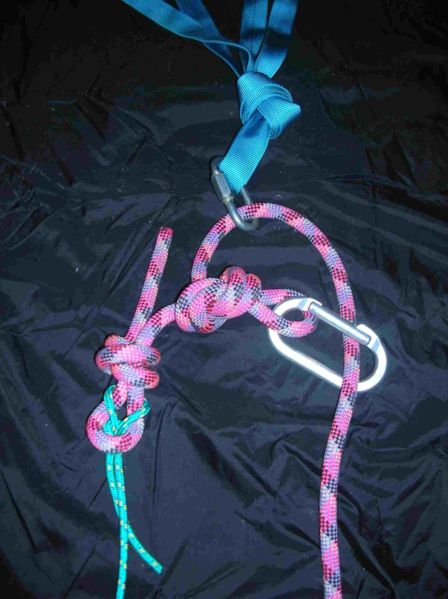
http://rockandice.com/articles/how-to-climb/article/791-reepschnur-review
An important note about reepschnur anchors!
The colorful illustration above shows a single sling attached to two anchors
(out of the picture) and properly tied in an overhand to prevent shock loading
in case one of the redundant redundant anchors fails. A single common hardware
store chain Quick Link is shown attached to the loop. A better configuration
would be to sling the two anchor points with sewn runners (they can be of
different lengths to accommodate two different anchor points) with two simple
two-dollar Quick Links. According to a printout provided by Ace Hardware, a
single Quick Link with a 1/4 inch opening (closed by its screw-nut gate) rates
850 pounds and a link with a 5/16 inch opening has a working load limit of 1,760
pounds. I carry two of the 1/4 inch quick links to leave at the rappel anchors:
$4.00 vs. $16.00.
--Webmeister Speik
.jpg)
Questions about this rope technique?
Q I have never heard of this "technique" and I climb allot at the Crags!
This is a traditional mountaineering technique. Ropes are very heavy,
even skinny alpine mountaineering ropes.
Mountaineers for the past 40 years, have often carried a light 6mm or 7mm static cord to extend their
rappels to the full length of their single climbing safety rope. Practice this reepschnur method at the
crags, of course, and amaze your friends. Then bag a few peaks with your friends (who learned with you).
Q. Why do you suggest the "new" Bachman autoblock and not cord?
Are you talking about a Prussic loop? The pesky problem with the prussic is
that it is either loose or it is jammed tight. The
new Bachman hitch gives you more control of the friction. But don't burn the
sling! Practice this at the crags with your peak bagger buddies!
Q. Why would I even think about using a Dulphersitz?
Many peak baggers leave their harness at home to save weight. Read the first
great book about techniques that were used to climb the epic faces in Yosemite:
Advanced Rockcraft by Royal Robbins,
illustrated by Sheridan Anderson La Siesta Press 1973
Read more about how to self belay your rappels!
All novice rappels should be belayed from above an icy
steep snow slope or crumbing scree or by top rope from the bottom of the cliff.
There are many reasons why a novice person rappelling can lose control. Read the 65 Annual
Reports of Accidents in North American Mountaineering to find them. In my
COCC Basic Mountaineering classes, we discussed ten possible rappelling problems and there are
many more.
Use of an "upper belay" rope is traditional when a local peak is bagged by a novice climbing club group. The weight and carry of the second rope is not a problem in this group situation.
A "fireman's belay" from the bottom is a possible alternative. A companion, standing below, adds friction by pulling down on the ends of the rappel rope. However, watch out for rocks being knocked off by the person rappelling. A local Cascades Mountaineers Club Member, not wearing a helmet, received a severe and bloody bonk on the head from a small rock dislodged by a nervous rappeller. He was using the fireman's belay at the bottom of the traditional rappel off Oregon's Mt. Washington, to the north side saddle.
Experienced traditional mountaineers will normally use the simple "self-belay" on long rappels with scary skinny alpine climbing ropes. Note that the typical belay device becomes scary hard to hold as you near the end of the rappel and the weight of the heavy dangling rope diminishes to nothing.
Just attach a correct prussic loop in thickness (depends on the rappel rope thickness, 5 to 6 mm?) and length (depends on the size of the climber - it must be long enough to clear the device but not out of reach when weighted) above the rappel device and link it to harness tie-in point with a second light locking carabiner. I personally prefer this original method with the prussic ABOVE the belay device. See the Mike Clelland illustration below from Climbing Ice, by Duane Raleigh, 1995 and from more recent Climbing Magazine Tech Tips.
Slide the prussic knot down the rope with the lower edge of your feeling hand on the rappel rope, being careful to not let the knot tighten up. See below.
Do NOT hold any prussic knot in your hand - in panic,
you will prevent it from tightening as you slide burning out of control down the
rope!
Slide the prussic knot down the rappel rope with the edge of your
hand
The prussic friction knot must be within reach of the climber if the knot becomes jammed and you find yourself hanging in mid air, from the knot!
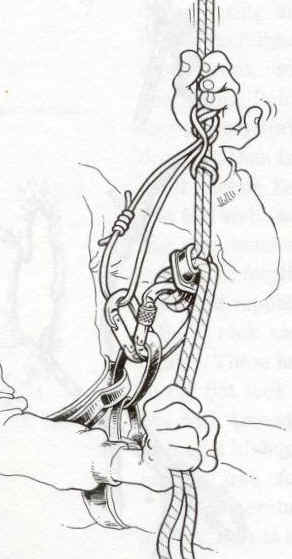
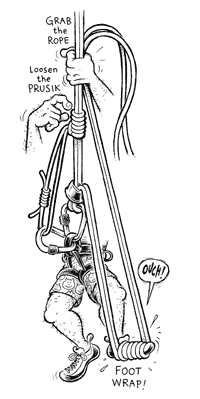
The Advanced Climbing Leader qualification tests I took in Southern California 35 years ago, required us to do a self belayed to a swami belt, dulphersitz rappel from 60 feet above the ground, jamb the prussic and then show that we could climb up, re-establish the rappel and release the prussic. With the overhanging rappel, you had to take a second longer prussic, girthed to a 48" sewn runner, attach it above the jammed self belay prussic, step up into the loop, take the weight off the jammed prussic knot, loosen the prussic knot and tighten up the rappel slack around your thigh, remove the step prussic and return it to your pocket and continue to the predetermined end of your rappel. Try this at the crags, protected by a secure upper belay and an interested, trusted belayer.
If you are doing a dulfersitz rappel, you can self belay with a swami runner
wrapped two or three times around your waste and tied each time, or a
48 inch figure eight sewn diaper runner and a locking biner to attach your long
prussic just below your upper "feeling hand". Have your second prussic and your second 48 inch runner in your pocket to climb back up the rappel rope or to loosen a jammed self
belay prussic knot. The total weight of this traditional gear is about 6 oz vs.16
oz. or a bit more for your BD Alpine Bod harness and light rappel device.
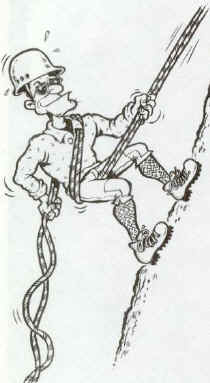
Illustration by Mike Clelland
From Climbing Ice, Duane Raleigh, 1995
This technique for climbing the rope sounds complicated but these are the skills you can use to climb back up the rope out of a crevasse or to climb back up the rappel rope to a better belay station, using a second prussic loop attached to the rope above the foot loop prussic and to your harness. I will write page on Climbing the Rappel Rope soon.
Here is the rest of the story!
Now, a newer technique for the rappel self belay has been recommended! I first read about this European method in the Petzl Catalog for 2005.
First, attach the rappel device locking carabiner to a 24" sewn runner by a slipknot and attach the other end of the runner by a girth hitch to the swami belt and leg loop of your harness. This technique extends the rappel device 12 inches up and away from bulky clothing, long hair, etc. where it can be seen and adjusted easily.
This technique makes possible using a prussic loop fixed on the tail of the rappel rope, linked to the leg loop of the harness by a light locking carabiner.
Stated again: With the belay device extended, attach a prussic loop to the tail of the rappel rope and then to your harness leg loop with a locking carabiner.
Also, there is a better alternative than the pesky prussic loop! Use a 24" runner, tied in a Franz Bachman friction knot, on the extended tail of the rappel rope and secure it to the large leg loop of your harness with a large light locking carabiner.
On May 4, 2005, Jim Ratz (52) fell to his death while rappelling from a route near his home in Lander, Wyoming. Jim was a NOLS Director, AMGA Director and Environmental Leader. Read more about Jim Ratz, here: http://traditionalmountaineering.org/News_JimRatz.htm.
Jim's friends did a detailed reconstruction of his accident. It is published in an eight page Report in the 59th Annual analysis of Accidents in North American Mountaineering - 2006. The Report found that failure of Jim's self belay system contributed to his death. His prussic self belay knot likely became caught in his belay device as he sought to stop at an intermediate belay ledge and he slid off the end of the doubled rappel rope high above the ground. Jed Williamson, long time Editor of ANAM, noted the following to me in an email comment on this page: "We also think the ropes weren't even. So he was on a single rope near the end of his slide, and because the autoblock was BELOW his device, it came right off. I personally still use the autoblock ABOVE the brake device. It won't ever come off."
Mike Clelland drew the illustration below which was included in the ANAM Report. Franz Bachman has sent me from Europe, this illustration of his Bachman Friction Knot! See the new self belay method and the latest Bachman friction knot below:
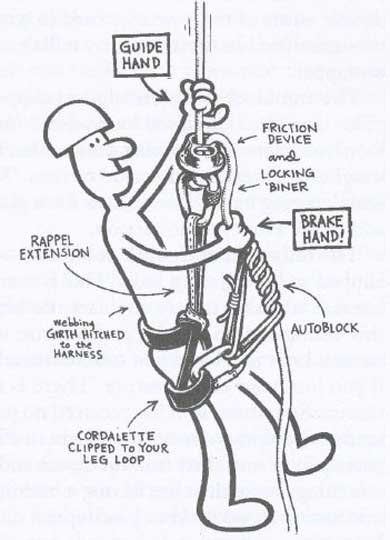
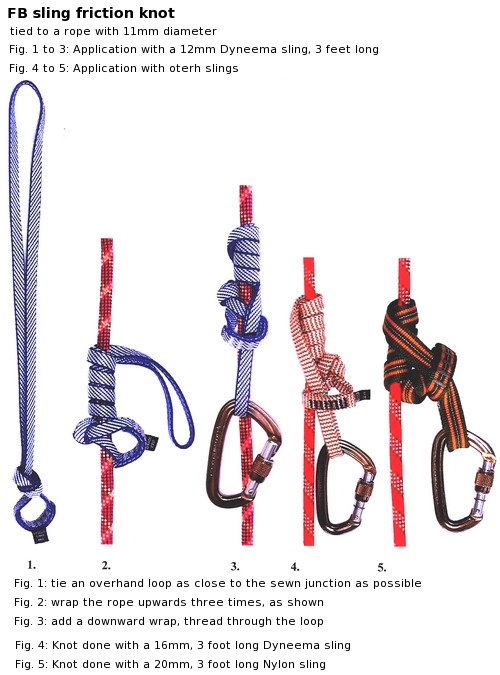
Traditional Mountaineering Rappelling Seminar at Meadow Crags near Bend
http://traditionalmountaineering.org/Photos_Seminar_Rappelling.htm
Use a 24 inch runner to put the device out about twelve inches. Girth hitch
to your harness (swami belt and leg loop) and tie in the rappel locker
with a
simple slip knot so it stays in place. Use a Bachman hitch on the tail of your
rappel rope.
Note that his Trango B-52 is reversed! details, details! --Robert Speik
"Traditional Mountaineering is about the mitigation of inherent risk with training,
technical gear and knowledge gained from the experiences of others who have gone
before." -Robert Speik
Read Chapter Eleven on Rappelling in Mountaineering, The Freedom of the Hills, 8th edition.
Copyright© 2000-2012 by Robert Speik. All Rights Reserved.
![]()
![]()
![]() WARNING - *DISCLAIMER!*
WARNING - *DISCLAIMER!*
Mountain climbing has inherent dangers that can in part, be mitigated
Read more . . .
Jim Ratz, climbing Leader, dies in climbing accident
as self belay fails
Brian Ellis, Yosemite
climber, falls 300 feet as Reepschnur fails
What is a dulfersitz rappel?
How can I self-belay a rappel?
What is the best alpine mountaineering harness?
What is the best belay | rappel | autoblock device for traditional alpine mountaineering?
![]()
Traditional mountaineering rappel practice in June 2008
Fatal climbing accident at Meadow Crags near Bend Oregon
Traditional Mountaineering Rappelling Seminar at Meadow Crags
CMC high angle rescue seminar at Meadow Crags
FREE TRADITIONAL MOUNTAINEERING CLINICS
Basic Rappelling - Instruction and Practice
Fatal climbing accident at Meadow Crags near Bend Oregon
Adopt a Crag Rebolting Project at Meadow Crags
The Access Fund Adopt a Crag event at Meadow Crags
Traditional Mountaineering Rappelling Seminar at Meadow Crags
CMC high angle rescue seminar at Meadow Crags
CMC Rescue, Inc. in Santa Barbara, CA
CARBORATION AND HYDRATION
Is running the Western States 100 part of "traditional mountaineering"?
What's wrong with GORP?
Answers to the quiz!
Why do I need to count carbohydrate calories?
What should I know about having a big freeze-dried dinner?
What about carbo-ration and fluid replacement during traditional alpine climbing?
4 pages in pdf
![]()
What should I eat before a day of alpine climbing?
REAL SURVIVAL STRATEGIES
FREE Clinic on Real Survival Strategies and Staying Found with Map, Compass and GPS together
What do you carry in your winter day and summit pack?
Why are "Snow Caves" dangerous?
Why are "Space Blankets" dangerous?
Why are "Emergency Kits" dangerous?
How can you avoid Hypothermia?
Missing climbers on Mount Hood, one dies of exposure, two believed killed in fall
Missing California family found, dad dies from exposure and hypothermia
Missing man survives two weeks trapped in snow-covered car
Missing snowmobile riders found, Roger Rouse dies from hypothermia
Olympic Champion Rulon Gardner lost on snowmobile!
Lost Olympic hockey player looses feet to cold injury
Expert skier lost five days near resort in North Cascades without map, compass, gps or cell phone
Mount Hood - The Episcopal School Tragedy
Mount Hood - experienced climbers rescued from snow cave
How can you learn the skills of snow camping?
Prospectus
ALPINE CLIMBING ON SNOW AND ICE
Winter mountaineering hazards - streams and lakes
Is long distance backpacking part of "traditional mountaineering"?
How long is the traditional alpine mountaineering ice axe?
What about climbing Mt. Hood?
What is a good personal description of the south side route on Mount Hood?
What should I know about travel over hard snow and ice?
How can I learn to self belay and ice axe arrest?
6 pdf pages
![]()
What should I know about snow caves?
What should I know about climbing Aconcagua?
AVALANCHE AVOIDANCE
Young Bend man dies in back county avalanche
What is an avalanche cord?
Avalanche training courses - understanding avalanche risk
How is avalanche risk described and rated by the professionals?
pdf table
How can I avoid dying in an avalanche?
Known avalanche slopes near Bend, OR?
What is a PLB?
Can I avoid avalanche risk with good gear and seminars?
pdf file
SNOWSHOES AND CRAMPONS
Why do you like GAB crampons for traditional mountaineering?
What should I know about the new snowshoe trails
What are technical snowshoes?
Which crampons are the best?
What about Boots and Shoes?
![]()
YOUR ESSENTIAL SUMMIT PACK
What are the new Ten Essential Systems?
What does experience tell us about Light and Fast climbing?
What is the best traditional alpine mountaineering summit pack?
What is Light and Fast alpine climbing?
What do you carry in your day pack?
Photos?
![]()
What do you carry in your winter day pack?
Photos?
![]()
Why are "Emergency Kits" dangerous?
What should I know about "space blankets"?
Where can I get a personal and a group first aid kit?
Photos?
YOUR LITE AND FAST BACKPACK
Which light backpack do you use for winter and summer?
Analysis
pdf
![]()
What would you carry in your backpack to climb Shasta or Adams?
![]()
What is the best traditional alpine mountaineering summit pack?
Photos of lite gear packed for a multi day approach to spring and summer summits
Backpack lite gear list for spring and summer alpine mountaineering
4 pdf pages
ESSENTIAL PERSONAL GEAR
What does Steve House wear for light and fast climbing?
What clothing do you wear for Light and Fast winter mountaineering?
What do you carry in your winter day pack?
Photos?
![]()
Which digital camera do you use in the mountains?
What about Boots and Shoes?
![]()
TRADITIONAL KNOWLEDGE
How did you become interested in traditional mountaineering techniques?
Who is Conrad Messner?
What is traditional slacklining or highlining?
What are some of the comments you have received?
Who was Peter Starr?
Who are the Mazamas?
What is an avalanche cord?
Who were the notorious Vulgarians?
How was top rope climbing practiced in the 1970s?
What is a Whillans sit harness?
BACKCOUNTRY NAVIGATION
How accurate is the inexpensive hand-held GPS today?
Can you get me a $30 rebate on your favorite GPS: Garmin's Legend?
pdf form
What are some good Central Oregon Geocaches?
What is the Public Land Survey Grid?
pdf
What is the UTM Grid?
six pdf pages
Which GPS do you like?
![]()
Which Compass do you like?
![]()
How do you use your map, compass and GPS together, in a nut shell?
How can I learn to use my map, compass and GPS?
Do you have map, compass and GPS seminar notes?
six pdf pages
ABOUT ALPINE MOUNTAINEERING
The Sport of Alpine Mountaineering
Climbing Together
Following the Leader
The Mountaineers' Rope
Basic Responsibilities
The Ten Essentials
Our Mission
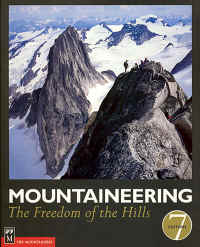
Read about rappelling in this book!